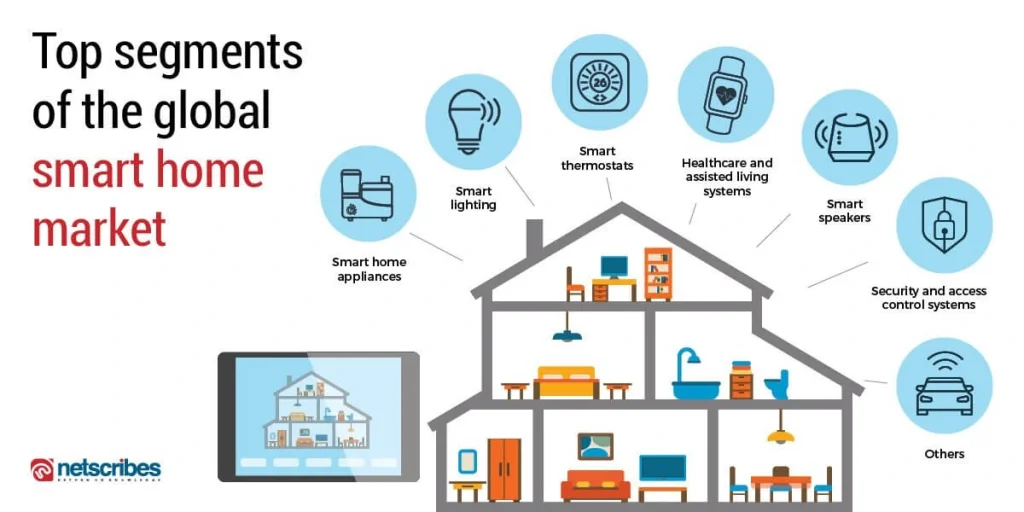The global smart home market: Key segments, growth drivers and trends

The smart home industry has been at the cusp of witnessing exponential growth for decades. But over the past five years, the industry has grown well beyond its early adoption stage. According to Netscribes research, the global smart home market is expected to be worth USD 151 billion by 2023.
The drivers of this exceptional growth are multifold. From the unprecedented penetration of smartphones backed by high-speed connectivity to the advancement in AI and speech-recognition technologies. Moreover, the increasing population of senior citizens in developing nations coupled with the growing need for energy savings has triggered the growth of the smart home market in recent years.

Growth drivers and opportunities
Smart home appliances communicate with each other in order to monitor energy consumption, offering an effective energy-saving solution. Smart buildings reduce water consumption by 30%, energy by 40%, triggering a strong wave of consumer adoption. Most smart home appliances can be controlled remotely using smartphones. This makes the future of the smart home market incredibly promising given that the number of mobile internet users expected to surge, from 3.3 billion in 2017 to 5 billion by 2025.
Furthermore, a substantial demand will emerge for advanced home security systems with the rapid growth in the elderly population, as they help them lead secure and independent lives. This market segment will drive the need for real-time, remote health-monitoring systems enabled by IoT. Developing regions like India, China, Latin America, and others are witnessing faster growth of this age group while their numbers in developed regions like Europe, North America, Australia, New Zealand, and Japan are relatively moderate.
Challenges facing the global smart home market
Hefty price tags are one of the most critical challenges hindering the smart home device penetration, especially across developing countries. For instance, the cost of smart locks ranges from USD 200 to USD 400.
Interoperability issues between devices and the need for installing multiple applications on smartphones are other niggles that affect this market. Even popular smart home products like Google Home, Apple Home Kit, Amazon Alexa, Amazon Echo, Philips Hue, and Samsung SmartThings support various wireless technologies or standards that are not interoperable.
While smart homes offer remote connectivity and monitoring, privacy and security concerns are emerging as a major threat deterring its adoption.
Key trends in the global smart home industry
- Integration with smart wearable devices
Smart wearables are the next big thing in consumer electronics. Analysts forecast that there will be nearly 1.1 billion units globally by 2022. As wearable gadgets increasingly become an indispensable part of consumer lives, it’s paving the way for more integration with smart home appliances.
- The surge in usage of M2M/IoT technologies and 5G
The advent of 5G networks, with its efficiency and high-speed, is a boon to the smart home market. IoT and M2M (Machine-to-Machine) are the most promising enablers that let smart home devices communicate over cloud-based applications to provide real-time updates; a critical factor in the security and remote healthcare space. - Artificial Intelligence will play a greater role
Advancements in AI-based technologies, such as computer vision and conversational AI, have further accelerated the proliferation of smart home technologies. It will continue to play a key role in transforming living spaces from analogous to autonomous. - The growing popularity of app-based smart security systems
Security has always been one of the top priorities for homeowners. The coming years will witness an increase in the adoption of app-based security systems for communities. These systems will offer remote access control over visitor authentication and validation. Devices such as security cameras (both indoor and outdoor), sensors, door locks, motion detectors, smoke detectors, and garage door openers are some of the most popular products in this category. - Voice at the heart of smart homes
Smart speakers are the most widespread home technologies across the globe. They not only provide users control over their smart home appliances but also double up as personal assistants reciting calendar events and more. Amazon Echo and Google Home have grown into household names commanding a sizable share of this expanding market.
For in-depth custom research and analysis of the smart home market, connect with us at info@netscribes.com.






